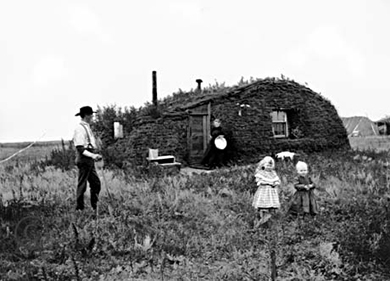| << Chapter < Page | Chapter >> Page > |
The challenges that many American farmers faced in the last quarter of the nineteenth century were significant. They contended with economic hardships born out of rapidly declining farm prices, prohibitively high tariffs on items they needed to purchase, and foreign competition. One of the largest challenges they faced was overproduction, where the glut of their products in the marketplace drove the price lower and lower.
Overproduction of crops occurred in part due to the westward expansion of homestead farms and in part because industrialization led to new farm tools that dramatically increased crop yields. As farmers fell deeper into debt, whether it be to the local stores where they bought supplies or to the railroads that shipped their produce, their response was to increase crop production each year in the hope of earning more money with which to pay back their debt. The more they produced, the lower prices dropped. To a hard-working farmer, the notion that their own overproduction was the greatest contributing factor to their debt was a completely foreign concept ( [link] ).

In addition to the cycle of overproduction, tariffs were a serious problem for farmers. Rising tariffs on industrial products made purchased items more expensive, yet tariffs were not being used to keep farm prices artificially high as well. Therefore, farmers were paying inflated prices but not receiving them. Finally, the issue of gold versus silver as the basis of U.S. currency was a very real problem to many farmers. Farmers needed more money in circulation, whether it was paper or silver, in order to create inflationary pressure. Inflationary pressure would allow farm prices to increase, thus allowing them to earn more money that they could then spend on the higher-priced goods in stores. However, in 1878, federal law set the amount of paper money in circulation, and, as mentioned above, Harrison’s Sherman Silver Act, intended to increase the amount of silver coinage, was too modest to do any real good, especially in light of the unintended consequence of depleting the nation’s gold reserve. In short, farmers had a big stack of bills and wanted a big stack of money—be it paper or silver—to pay them. Neither was forthcoming from a government that cared more about issues of patronage and how to stay in the White House for more than four years at a time.
The initial response by increasingly frustrated and angry farmers was to organize into groups that were similar to early labor unions. Taking note of how the industrial labor movement had unfolded in the last quarter of the century, farmers began to understand that a collective voice could create significant pressure among political leaders and produce substantive change. While farmers had their own challenges, including that of geography and diverse needs among different types of famers, they believed this model to be useful to their cause.

Notification Switch
Would you like to follow the 'U.s. history' conversation and receive update notifications?